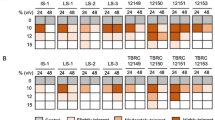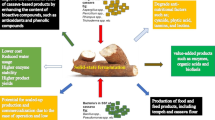Abstract
Nineteen Rhizopus strains were selected and tested for their growth capacity on raw cassava starch and their ability to produce amylase when grown on solid-state fermentations. Only three strains grew significantly on this natural substrate. Glucoamylase production was higher on raw cassava than on cooked cassava. After 48 h of fermentation, the protein content of cassava was increased from 1.75% to 11.3%. The byproducts of fermentation were fumaric acid, lactid acid and ethanol.
Similar content being viewed by others
References
Alazard D, Raimbault M (1981) Comparative study of amylolytic enzymes production by Aspergillus niger in liquid and solid-state cultivation. Eur J Appl Microbiol 12:113–117
Beuchat LR (1987) Food and beverage mycology, 2nd edn. Van Nostrand Reinhold, New York
Cook JH (1982) Cassava: a basic energy source in the tropics. Science 218:755–762
Daubresse P, Ntibashirwa S, Gheysen A, Meyer JA (1987) A process for protein enrichment of cassava by solid substrate fermentation in rural conditions. Biotechnol Bioeng 29:962–968
Fassatiova O, (1986) Moulds and filamentous fungi in technical microbiology. Prog Ind Microbiol 22:1–233
Fujio Y, Suyanadona P, Attasampunna P, Ueda S (1984) Alcoholic fermentation of raw cassava starch by Rhizopus koji without cooking. Biotechnol Bioeng 26:315–319
Giraud E, Lelong B, Raimbault M (1991) Influence of pH and initial lactate concentration on the growth of Lactobacillus plantarum. Appl Microbiol Biotechnol 36:96–99
Hasseltine CW (1965) A millennium of fungi, food and fermentation. Mycologia 57:149–197
Ko SD (1988) Self protection of fermented foods against aflatoxin. Proceedings of fats oils by immobilized fungus at constant water concentration. J Ferment Technol 66:567–575
Lowry OH, Rosebrough NJ, Farr AL, Randall RJ (1951) Protein measurement with the Folin phenol reagent. J Biol Chem 193:265–275
Miller GL (1959) Use of dinitrosalicylic acid reagent for determination of reducing sugars. Anal Chem 31:426–428
Onions AHS, Allsopp D, Eggins HOW (1981) Smith's introduction to industrial mycology, 7th edn. Edward Arnold, London
Oriol E, Schetino B, Viniegra-Gonzalez G, Raimbault M (1988a) Solid state culture of Aspergillus niger on support. J Ferment Technol 66:57–62
Oriol E, Raimbault M, Roussos S, Viniegra-Gonzalez G (1988b) Water and water activity in the solid state fermentation of cassava starch by Aspergillus niger. Appl Microbiol Biotechnol 27:498–503
Oteng-Gyang K (1979) Etude de levures amylolytiques en vue de la production de protéines d'organismes unicellulaires. Thèse de doctorat de troisième cycle en Génie et Technologie Alimentaires, Université des Sciences et Techniques du Languedoc, Montpellier
Padmaja GB, Balagopal C (1985) Cyanide degradation by Rhizopus oryzae. Can J Microbiol 31:663–669
Raimbault M (1981) Fermentation en milieu solide. Croissance de champignons filamenteux sur substrat amylacé. Trav Doc ORSTOM 127:1–291
Raimbault M (1989) Solid state fermentation in bioconversion of agro-industrial raw materials. In: Raimbault M (eds) Proceedings of the EC Seminar held at Montpellier 25–27 July, 1988. Editions de l'ORSTOM, Paris, p 143
Samson RA, Reenen-Hoekstra ES van (1988) Introduction to food borne fungi, 3rd edn. Centralbureau voor Schimmelcultures, Institute of the Royal Netherlands, Academy of Arts and Sciences, Baarn, Delft
Soccol CR (1992) Physiologie et métabolisme de Rhizopus en culture solide et submergée en relation avec la dégradation d'amidon cru et la production d'acide l(+)lactique. Doctoral thesis, Université de Technologie de Compiègne, Compiègne, France
Soccol CR, Cabrero MA, Roussos S, Raimbault M (1992) Selection of Rhizopus for growing on raw cassava. In: Guerrero R (ed) Proceedings of the VI International Symposium on Microbial Ecology, Barcelona, 6–11 September 1992, p 302
Wang HL, Ruttle DI, Hesseltine CW (1969) Antibacterial compound from a soy-bean product fermented by Rhizopus oligosporus. Proc Soc Exp Biol Med 131:579–583
Zhu CR, Du MJ, Lei DN, Wan LQ (1989) A study on the inhibition of aflatoxin B1-induced hepatocarcinogenesis by Rhizopus delemar. Mater Med Pol 21:87–91
Author information
Authors and Affiliations
Rights and permissions
About this article
Cite this article
Soccol, C.R., Marin, B., Raimbault, M. et al. Breeding and growth of Rhizopus in raw cassava by solid state fermentation. Appl Microbiol Biotechnol 41, 330–336 (1994). https://doi.org/10.1007/BF00221228
Received:
Revised:
Accepted:
Issue Date:
DOI: https://doi.org/10.1007/BF00221228




